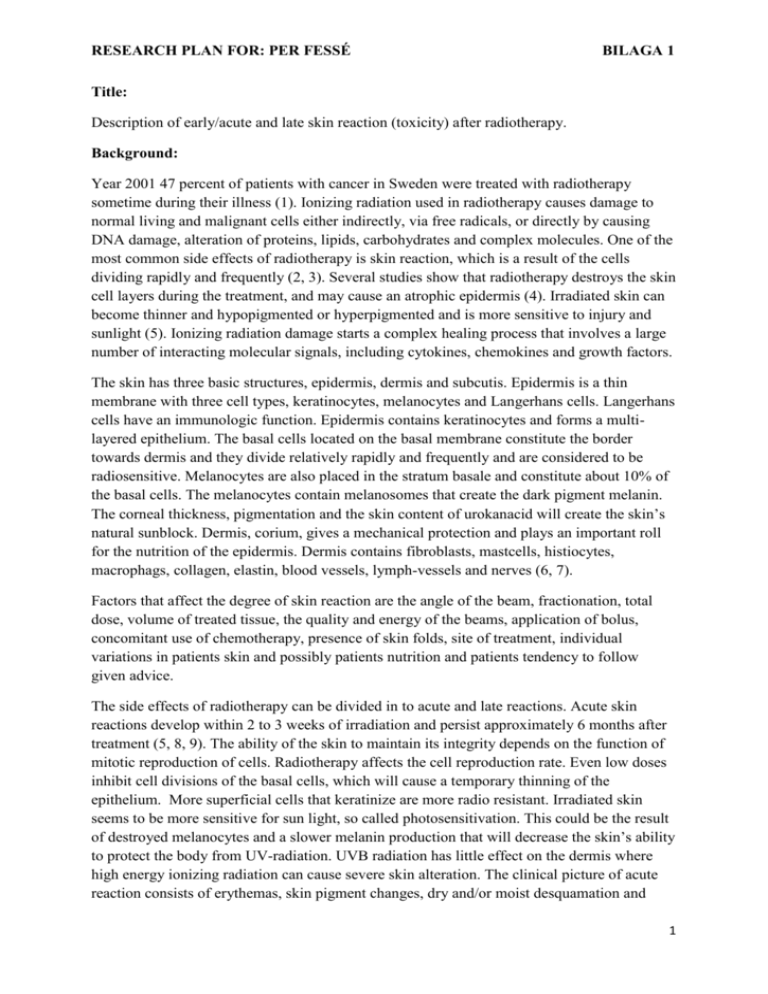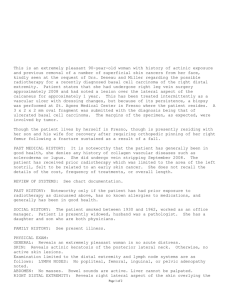Title:
advertisement

RESEARCH PLAN FOR: PER FESSÉ BILAGA 1 Title: Description of early/acute and late skin reaction (toxicity) after radiotherapy. Background: Year 2001 47 percent of patients with cancer in Sweden were treated with radiotherapy sometime during their illness (1). Ionizing radiation used in radiotherapy causes damage to normal living and malignant cells either indirectly, via free radicals, or directly by causing DNA damage, alteration of proteins, lipids, carbohydrates and complex molecules. One of the most common side effects of radiotherapy is skin reaction, which is a result of the cells dividing rapidly and frequently (2, 3). Several studies show that radiotherapy destroys the skin cell layers during the treatment, and may cause an atrophic epidermis (4). Irradiated skin can become thinner and hypopigmented or hyperpigmented and is more sensitive to injury and sunlight (5). Ionizing radiation damage starts a complex healing process that involves a large number of interacting molecular signals, including cytokines, chemokines and growth factors. The skin has three basic structures, epidermis, dermis and subcutis. Epidermis is a thin membrane with three cell types, keratinocytes, melanocytes and Langerhans cells. Langerhans cells have an immunologic function. Epidermis contains keratinocytes and forms a multilayered epithelium. The basal cells located on the basal membrane constitute the border towards dermis and they divide relatively rapidly and frequently and are considered to be radiosensitive. Melanocytes are also placed in the stratum basale and constitute about 10% of the basal cells. The melanocytes contain melanosomes that create the dark pigment melanin. The corneal thickness, pigmentation and the skin content of urokanacid will create the skin’s natural sunblock. Dermis, corium, gives a mechanical protection and plays an important roll for the nutrition of the epidermis. Dermis contains fibroblasts, mastcells, histiocytes, macrophags, collagen, elastin, blood vessels, lymph-vessels and nerves (6, 7). Factors that affect the degree of skin reaction are the angle of the beam, fractionation, total dose, volume of treated tissue, the quality and energy of the beams, application of bolus, concomitant use of chemotherapy, presence of skin folds, site of treatment, individual variations in patients skin and possibly patients nutrition and patients tendency to follow given advice. The side effects of radiotherapy can be divided in to acute and late reactions. Acute skin reactions develop within 2 to 3 weeks of irradiation and persist approximately 6 months after treatment (5, 8, 9). The ability of the skin to maintain its integrity depends on the function of mitotic reproduction of cells. Radiotherapy affects the cell reproduction rate. Even low doses inhibit cell divisions of the basal cells, which will cause a temporary thinning of the epithelium. More superficial cells that keratinize are more radio resistant. Irradiated skin seems to be more sensitive for sun light, so called photosensitivation. This could be the result of destroyed melanocytes and a slower melanin production that will decrease the skin’s ability to protect the body from UV-radiation. UVB radiation has little effect on the dermis where high energy ionizing radiation can cause severe skin alteration. The clinical picture of acute reaction consists of erythemas, skin pigment changes, dry and/or moist desquamation and 1 RESEARCH PLAN FOR: PER FESSÉ BILAGA 1 epilation. When the area has recovered from the acute reaction, the skin can become thinner, smother, pinkish and dryer. In a previuos study (10) from our institution biopsies of the skin were taken after completing the treatment (total dose =54Gy). It was shown that the epidermis was thin and contained only one to three layers of keratinocytes and was enlarged with abnormal cytology. Late side effects are mainly related to vascular and connective tissue changes. Atrophy of the skin, telangiectasia, a changed pigmentation, fibrosis, in rare cases ulceration and necrosis, are late skin reactions. Late reactions take months to years before they appear. Late reactions are usually changes that are permanent and are more related to the total dose that is given and volume of tissue that has been treated. Melanocytes are relatively radiation resistant (5, 8). However the whole complex processes behind acute and late skin reactions after radiotherapy are not evidently described (4). The personnel also often advise the patients to protect the irradiated skin against sunlight the clinical evidence for this recommendation is scarce and should be investigated further. Purpose: Up to now most research in this field has focused on the keratinocyte toxicity. There is virtually no data on the role of the melanocyte in this process. Therefore the aim of this project is to evaluate the response of the melanocytes to irradiation and how it affects the degree of skin toxicity after radiotherapy. Study-plan/Method: 1) The aim of the project was to evaluate melanocytes if there is a dose range where lowdose hypersensitivity and an increased radioresistance occur. Another objective was to compare the DNA damage response of ionizing radiation to that known for UVR. Material that was investigated was 260 skin punch biopsies from 33 men treated for prostate cancer with radiotherapy (11, 12). Biopsies were taken at 1 week and 6.5 weeks into the treatment course, from regions of the exposed to fraction doses 0.1, 0.2, 0.45 and 1.1 Gy. Control biopsies were collected before treatment. Sections from the biopsies were stained with ∆Np63, eosin-PAS, MITF and Bcl-2. The total number of identified cells per mm of the basal membrane was counted for all biopsies on three separate sections for each immunostaining, as well as the morphological staining. All counting was performed by one of the authors (PF) in a bright field microscope with a 100 x objective. A total of 3120 separate sections was counted and analyzed. Cells in the melanocyte lineage are negative for ∆Np63. The numbers of ∆Np63-negative cells were constant and independent of dose per fraction over the treatment and unchanged from unexposed skin. Small but consistent increase of eosin-PAS, MITF and Bcl-2 stained melanocytes were observed. Repeated dose fraction over 0.05 Gy trigger melanocytes to express higher levels of MITF and Bcl-2. During the research found a 2 RESEARCH PLAN FOR: PER FESSÉ BILAGA 1 subpopulation of MITF negative cells that suggest that undifferentiated cells do exist in unirradiated interfollicular epidermis. Upon low doses of radiation this subset upregulates MITF and Bcl-2. The findings are compatible with an induction of radioresistance and supports that the DNA damage response of melanocytes to ionizing and UVR shares common main pathways. A draft manuscript has been written and it will be submitted for publication during October or November 2010. 2) Aim of the second project is to evaluate melanocytes response during treatment and after treatment. The investigated material is 147 skin punch biopsies from 15 breast cancer patients that have received post-mastectomy radiotherapy 2 Gy 5 times a week under a period of 5 weeks. Biopsies were taken once a week during treatment and up to 5 weeks past treatment. Control biopsies were collected before treatment. Sections from the biopsies were stained with ∆Np63, MITF and Bcl-2. The total number of identified cells per mm of the basal membrane is counted for all biopsies on three separate sections for each immunostaining, as well as the morphological staining. All counting is performed by one of the authors (PF) in a bright field microscope with a 100 x objective. A total of 1323 separate sections and most of the sections are counted and planned to be finished end of October 2010. All data will be analyzed under November 2010. Cells in the melanocyte lineage are negative for ∆Np63. Preliminary results follow same response during treatment as project 1, but 4 to 5 weeks past treatment the number of stained melanocytes has stabilized to same amount as before treatment. The subpopulation of MITF negative cells follow same pattern as project 1 and they also recover to same amount of cells as before treatment 4-5 weeks after treatment. This supports the idea that melanocytes and undifferentiated melanocytes need the keratinocytes to survive and recover. A draft manuscript is planned to be written December 2010 and it will be submitted for publication during January or February 2011. 3) Aim of the third project is to investigate if there is a keratinocyte dependency to melanocytes survival and reaction and possible differences in the adverse effects in the skin after radiotherapy. If the survivals of melanocytes end thereby late changes in skin pigmentation is dependent on early damage to the keratinocytes. The third project will use photographic pictures taken of the treatment area in women that has received post-mastectomy radiotherapy (13). A picture was taken once a week during treatment and at follow-up visits up to 5-10 years after treatment. There were 9 different fractionation schemes with about 25 women in each group. This makes a total of about 225 women. Four schemes were 2 Gy 5 times a week for 20, 25, 30 or 35 fractions. Five schemes 4 Gy 2 times a week for 8, 10, 11, 12 or 14 fractions. Each photograph is going to be scored visually 1-5 regarding skin reaction and pigmentation up to the 5 year follow up. All the photographs are filed in Gothenburg, I will start scoring the pictures in March and that will take approximately one week. The late reactions, ie hypo- or hyperpigmentation will be compared with the degree of early skin reaction. If a severe early skin reaction, ie keratinocyte damage, is correlated with a late hypopigmentation in the skin, it will support the hypothesis that melanocytes 3 RESEARCH PLAN FOR: PER FESSÉ BILAGA 1 depend on keratinocytes to survive ionizing radiation. All data will be analyzed under March 2011. A draft manuscript is planned to be written March/April 2011 and it will be submitted for publication during May or June 2011. Importance: This research can give fundamental knowledge about the melanocytes role and their sensitivity during and after radiotherapy. If radiotherapy changes the skin character and increases its sensitivity the patient’s way of life can be affected. Data of melanocytes and undifferentiated melanocytes dependency of keratinocytes communication that influence melanocytes and undifferentiated melanocytes ability to recover and defend their self’s for survival can help us understand some of the side effects in the skin that our patients experience, like hypo pigmentation. If patients react with certain skin side effects the research data will support better information to the patients that their normal defense mechanism in the treated skin area can be affected and they need to be more careful in the sun then the normal population. Increased knowledge on the skin’s structural changes and what processes are affected over time will help healthcare personnel to give more appropriate advice about skin care to the group of patients receiving this type of treatment. Other aspects of the puzzle of knowledge in the understanding of melanocytes survival and communication is that in the long run the research data can help the melanoma research further how to isolate mutated melanocytes and treat these cells. 4 RESEARCH PLAN FOR: PER FESSÉ BILAGA 1 References: (1) Statens beredning för utvärdering av medicinsk metodik. SBU-rapport. Strålbehandling vid cancer. En systematisk litteratur översikt. 2003 Nr 162 (2) Reitan A M , Schölberg T (red), Översättning Jones L. Onkologisk omvårdnad. (2003). Stockholm: Liber AB. (3) Ringborg U, Henriksson R, Friberg S. Onkologi. (1998). Stockholm: Liber AB. (4) Denham J, Hauer-Jensen M. The radiotherapeutic injury – a complex ‘wound’. Radiotherapy&Oncology. 2002;63:129-145. (5) Sitton E. Early and late radiation -induced skin alterations. Part 1: Mechanisms of skin changes. Oncology Nursing Forym 1992;19:801-807 (a). (6) Rorsman H, Björnberg A, Vahlquist A. Dermatologi Venereologi. (2000). Lund: Studentlitteratur. (7) Nylén P m fl. Ultraviolett strålning och hälsa – ett kunskapsunderlag. Arbetslivsinstitutet, Arbete och Hälsa vetenskaplig skriftserie. 2002 Nr 2002:5. (8) Groenwald S, Hansen Frogge M, Goodman M & Henke Yarbro C. (1997). Cancer Nursing Principles and Practice. Boston: Jones & Bartlett. (9) Porock D. Factors influencing the severity of radiation skin and mucosal reactions: development of a conceptual framework. Eur J Cancer Care. 2002;11:33-43. (10) Ponten F, Lindman H, Bostrom A, Berne B, Bergh J. Induction of p53 expression in skin by radiotherapy and UV radiation: a randomized study. J Natl Cancer inst. 2001 Jan 17;93:2:128-33. (11) Joiner MC, Marples B, Lambin P, Short SC, Turesson I. Low-dose hypersensitivity: current status and possible mechanisms. Int J Radiat Oncol Biol Phys 2001;49:2:379-89. (12) Turesson I, Bernefors R, Book M, Flogegård M, Hermansson I, Johansson KA, Lindh A, Sigurdardottir S, Thunberg U, Nyman J. Normal tissue response to low doses of radiotherapy assessed by molecular markers –a study of skin in patients treated for prostate cancer. Acta Oncol 2001;40:8:941-951. (13) Nyman J, Turesson I. Basal cell density in human skin for various fractionation schedules in radiotherapy. Radiother Oncol 1994;33:2:117-24. 5








